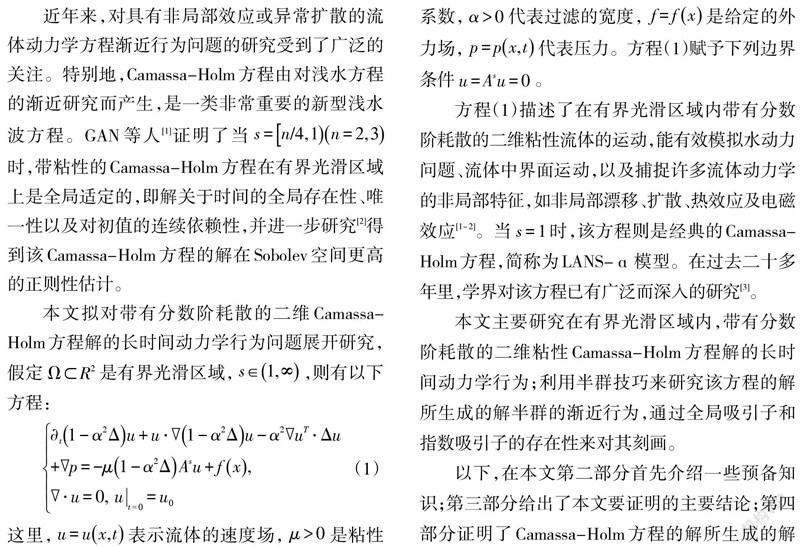带有分数阶耗散的二维Camassa-Holm方程的渐近行为
杨佳佳



摘 要:本文主要研究带有分数阶耗散的二维Camassa-Holm方程在有界光滑区域上解的长时间动力学行为问题。通过利用半群分解技巧来证明该方程的解所生成的解半群的渐近紧性,从而得到全局吸引子和指数吸引子在相空间中的存在性。
关键词:粘性Camassa-Holm方程;全局吸引子;指数吸引子
中图分类号:O19 文献标识码:A 文章编号:2095-7394(2021)04-0038-10
近年来,对具有非局部效应或异常扩散的流体动力学方程渐近行为问题的研究受到了广泛的关注。特别地,Camassa-Holm方程由对浅水方程的渐近研究而产生,是一类非常重要的新型浅水波方程。GAN等人[1]证明了当[s=n/4,1n=2,3]时,带粘性的Camassa-Holm方程在有界光滑区域上是全局适定的,即解关于时间的全局存在性、唯一性以及对初值的连续依赖性,并进一步研究[2]得到该Camassa-Holm方程的解在Sobolev空间更高的正则性估计。
本文拟对带有分数阶耗散的二维Camassa-Holm方程解的长时间动力学行为问题展开研究,假定[Ω?R2]是有界光滑区域,[s∈1,∞],则有以下方程:
方程(1)描述了在有界光滑区域内带有分数阶耗散的二维粘性流体的运动,能有效模拟水动力问题、流体中界面运动,以及捕捉许多流体动力学的非局部特征,如非局部漂移、扩散、热效应及电磁效应[1-2]。当[s=1]时,该方程则是经典的Camassa-Holm方程,简称为LANS-ɑ模型。在过去二十多年里,学界对该方程已有广泛而深入的研究[3]。
本文主要研究在有界光滑区域内,带有分数阶耗散的二维粘性Camassa-Holm方程解的长时间动力学行为;利用半群技巧来研究该方程的解所生成的解半群的渐近行为,通过全局吸引子和指数吸引子的存在性来对其刻画。
以下,在本文第二部分首先介绍一些预备知识;第三部分给出了本文要证明的主要结论;第四部分证明了Camassa-Holm方程的解所生成的解半群的连续性;第五、六部分,基于半群分解技巧证明了解半群的渐近紧性,从而得到全局吸引子和指数吸引子的存在性。
参考文献:
[1] GAN Z H,CENTER FOR APPLIED MATHEMATICS TIANJIN UNIVERSITY TIANJIN CHINA,LIN F H,et al. On the viscous Camassa-Holm equations with fractional diffusion[J]. Discrete & Continuous Dynamical Systems- A,2020,40(6):3427-3450.
[2] GAN Z H,GUO Q,LU Y. Regularity and stability of finite energy weak solutions for the Camassa-Holm equations with nonlocal viscosity[J]. Calculus of Variations and Partial Differential Equations,2021,60(1):1-27.
[3] MARSDEN J E,SHKOLLER S. Global well-posedness for the Lagrangian averaged Navier-Stokes(LANS-α) equations on bounded domains[J]. Philosophical Transactions of the Royal Society of London Series A: Mathematical,Physical and Engineering Sciences,2001, 359(1784):1449-1468.
[4] ROBINSON J C,PIERRE C. Infinite-dimensional dynamical systems:an introduction to dissipative parabolic PDEs and the theory of global attractors. Cambridge texts in applied mathematics[J]. Applied Mechanics Reviews,2003,56(4):B54-B55.
[5] Huang A,Huo W. The global attractors of the 2D Boussinesq equations with fractional Laplacian in subcritical case[J]. Discrete and Continuous Dynamical Systems-Series B (DCDS-B),2017,21(8):2531-2550.
[6] FOIAS C,MANLEY O,ROSA R,et al. Navier-stokes equations and turbulence[M]. Cambridge:Cambridge University Press,2001,136-168.
[7] HALE J. Asymptotic behavior of dissipative systems[M]. Providence,Rhode Island:American Mathematical Society,1998,175-184.
[8] KALANTAROV V K,TITI E S. Global attractors and determining modes for the 3D Navier-Stokes-Voight equations[J]. Chinese Annals of Mathematics,Series B, 2009,30(6):697-714.
[9] LADYZHENSKAYA O. Evolution equations of hyperbolic type[M]//Attractors for semigroups and evolution equations. Cambridge:Cambridge University Press,1991: 43-69.
[10] TEMAM R. Infinite-dimensional dynamical systems in mechanics and physics[M]. New York,NY:Springer US, 1988,56-72.
[11] FABRIE P,GALUSINSKI C,MIRANVILLE A,et al. Uniform exponential attractors for a singularly perturbed damped wave equation[J]. Discrete and Continuous Dynamical Systems,2004,10(1/2):211-238.
[12] COTI ZELATI M,GAL C G. Singular limits of Voigt models in fluid dynamics[J]. Journal of Mathematical Fluid Mechanics,2015,17(2):233-259.
責任编辑 王继国

